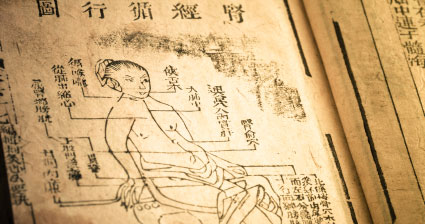The Evolution of Acupuncture

Three things happened to advance our medicine that are important to recognize. First, as acupuncture moved from China to the rest of the world, it changed. As the world expanded through transportation and communication, so did our medicine. It first reached Japan in about 6 AD and then trickled out to Korea, Vietnam, and other Asian nations, eventually reaching Europe and North America. With each new location, different diagnostic and treatment styles developed.
Second, treatment tools and sanitation techniques have expanded. Thank goodness! You can be glad you weren't an acupuncturist back in the stone ages. The popular treatment tools at the time were stone needles and knives. Ouch! Metal needles didn't arrive until the Bronze Age. Later, silver and gold needles became the new big thing.
Acupuncture became safer with the advent of modern sterilization techniques. Although autoclave machines haven't been used in common practice for quite some time, I actually had to study the settings for them in order to pass my exams in college. Can you imagine living in an era where you had to reuse acupuncture needles? Remember, those old silver and gold needles were expensive and you wouldn't want to dispose of them. Fortunately, reliable, clean and safe disposable needles as we know them today became common in about the 1970's. Of course, we now have many treatment options besides needles, which we'll talk about in a bit.
And finally, diagnosis and treatment strategies have evolved over time. As the diseases of the world have changed, so have our strategies for diagnosis and treatment. The recognition of infectious disease, known as "Febrile Disease," was introduced during the Han Dynasty (206 BC to 220 AD). The first existence of small pox, for example, can be traced back in Chinese medicine history to the Jin dynasty (281-341 AD). Modern disease like autoimmune disorders were not recognized during ancient times.
With the recognition of new diseases came new treatment styles such as moxibustion and cupping. Unlike treatment styles, diagnostic methods like pulse reading have not historically changed much — that is, until recent times. Advances in technology are bringing changes in diagnostic methods for modern acupuncture.
The Best of Both Worlds
Our medicine is unique and we should never forget the foundation from which it came. We have a holistic approach to treatment that's worked for more than 2500 years and has evolved into an amazing medicine with so many possibilities.
 Don't ever forget where we came from, but remember this. Progress is good. The advancement of our medicine has been phenomenal up to this point. We, as individuals, can improve our treatment and diagnostic strategies without letting go of the traditional theory we learned in school. In fact, it's our duty to improve.
Don't ever forget where we came from, but remember this. Progress is good. The advancement of our medicine has been phenomenal up to this point. We, as individuals, can improve our treatment and diagnostic strategies without letting go of the traditional theory we learned in school. In fact, it's our duty to improve.
If you think we can't change because we are practicing the way we did 2000 years ago, it's time to wake up and realize we are not. The founders of Chinese medicine adapted and expanded as the world changed. They developed new theories and treatment styles that worked. I think they would be upset if we didn't continue to grow just as they did. Just because you studied "Traditional Chinese Medicine" doesn't mean you can't use modern technology in your practice. In the 21st Century, we get the best of both worlds! I am a Modern Acupuncturist. Are you?
By Kimberly Thompson, LAc

No comments:
Post a Comment